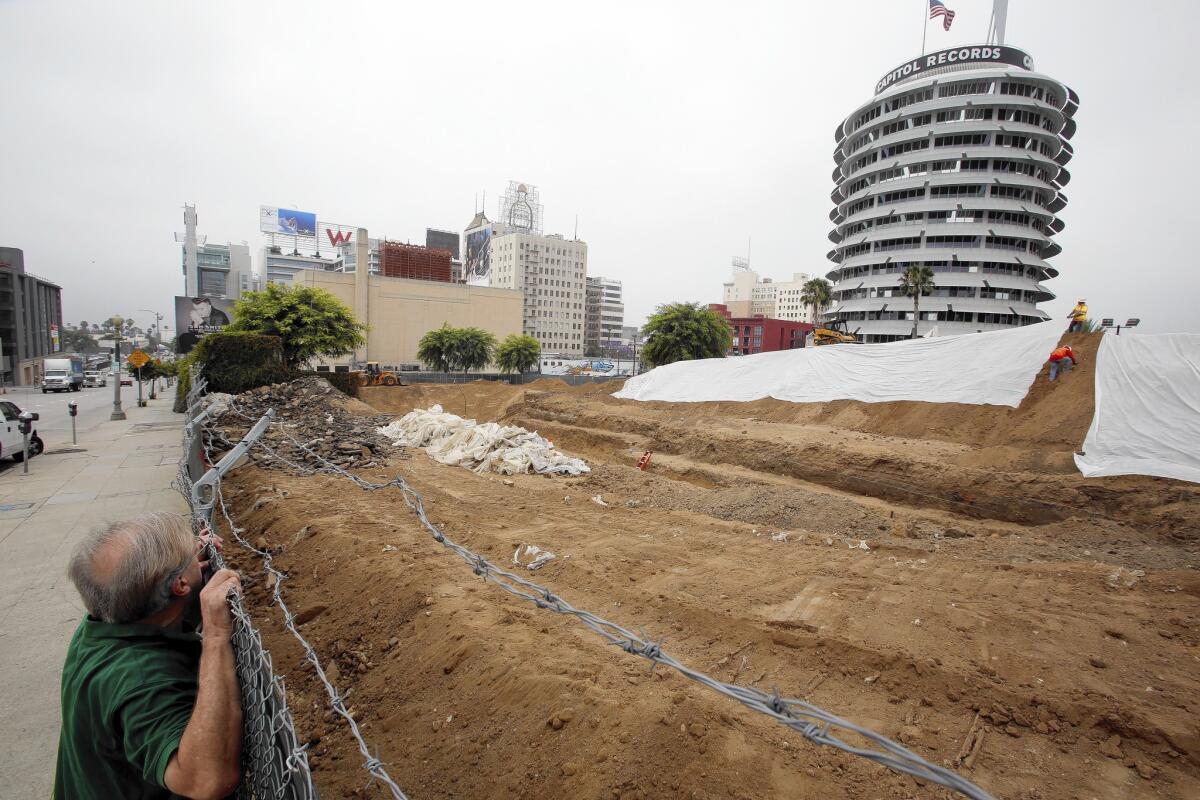Developers’ study finds no active faults under Hollywood projects

- Share via
A consultant hired by the developers of several large Hollywood projects said his studies found no evidence of an active earthquake fault underneath the properties and is asking the state to reflect that in its official regulatory maps.
The consultant, Michael Reader, said that after comprehensive studies under four properties at the intersection of Argyle Avenue and Yucca Street, his firm was unable to find the active fault drawn by the California Geological Survey in its proposed zoning map of the Hollywood earthquake fault.
The state’s map has been the subject of much debate because it placed the Hollywood fault zone through the iconic Capitol Records tower and Millennium project, where a developer plans to build Hollywood’s tallest skyscrapers, at 39- and 35-stories tall. The map estimates the fault also goes through other developments.
Reader said his firm did find minor faults under two properties across the street from the Millennium site, and a proposed apartment complex at the former KFWB-AM radio studio. But tests showed these faults last shook so long ago that they are considered inactive. California law defines faults that ruptured within the last 11,000 years as active.
“We showed that there are no faults that are active within the four study areas,” said Reader, who provided a five-page summary of his findings to the state Mining and Geology Board.
State geologist John Parrish said his agency has not yet reviewed Reader’s report. But he said he would need more than the synopsis Reader provided before making any changes.
We “would not make changes to a map based on a summary letter from a contractor, but rather only from a direct review and analysis of the data itself,” Parrish said in an email. He said his agency uses data from many reports “to obtain the most accurate and complete picture.”
Reader said his firm, Group Delta, dug four trenches, and took dozens of soil and sonar samples, which so far have cost the developers more than $1 million, he said.
He said working on all four properties was like piecing together a “geological jigsaw puzzle,” and his firm was only able to reach these conclusions because they were hired and had access to study all the locations at the same time.
The state board will review the appeals Thursday morning during a meeting at the Capitol. In a report, board Executive Officer Stephen Testa outlined options the board could take, which includes recommending the state geologist remove that portion of the fault from the final map pending the new data, “unless the conclusions indicate a sufficiently active and well-defined fault” at that intersection.
The state geological survey, headed by Parrish, has final say over how the map is drawn, Testa said in the report.
The state’s preliminary map was drawn from a detailed review of published professional data and academic studies in the Hollywood area.
When finalized, the state’s map requires anyone seeking to build in a zone roughly 500 feet from the estimated path of the fault to do a detailed earthquake fault study. The study aims to ensure a structure is not constructed on top of the fault.
The final say over whether a structure can be built lies with Los Angeles’ Department of Building and Safety, which must determine if a developer has done sufficient underground study and demonstrated whether a structure can be built safely away from any active faults.
As the project proposals move forward, Reader will be submitting data to the city from the four trenches, which were 120 to 200 feet long and up to 35 feet deep, as well as dozens of sonar and soil samples up to 60 feet deep.
Millennium officials last summer said their initial studies showed the fault does not cross the project site, but agreed to additional studies at the request of the city’s building department.
In a statement Monday, Philip Aarons of Millennium Partners said a full report of the investigation is being finalized, and will be submitted to city officials later this month.
“As we have said repeatedly over the last year, Millennium Hollywood is steadfast in its commitment to build a safe project that conforms to the highest earthquake resiliency standards,” Aarons said in the statement. “And getting the best information possible allows us to start planning toward that reality.”
The Hollywood fault zone is expected to be finalized later this year.
More to Read
Sign up for Essential California
The most important California stories and recommendations in your inbox every morning.
You may occasionally receive promotional content from the Los Angeles Times.












